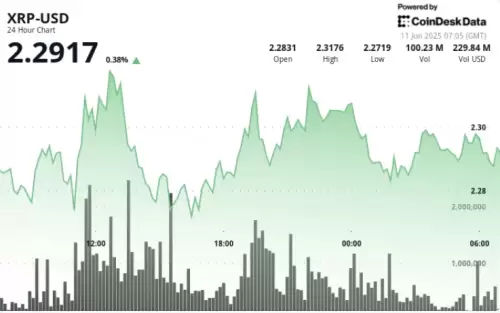 |
|
 |
|
 |
|
 |
|
 |
|
 |
|
 |
|
 |
|
 |
|
 |
|
 |
|
 |
|
 |
|
 |
|
 |
|
暗号通貨のニュース記事
As Global Trade Tensions Intensify, Investors Scramble for Safe Havens, Sending Gold Prices Soaring to Historic Highs
2025/05/02 01:11

Global financial markets experienced a week of seismic shifts as investors grappled with intensifying trade tensions and macroeconomic uncertainty. Among the key changes, gold prices soared to new highs, while gasoline prices continued their decline.
As the US administration escalated its trade war with China, announcing new tariffs of 145% on a vast range of Chinese goods, macroeconomic risk appetite soured. This was particularly evident with the massive sell-off in long-dated US Treasurys, a move that typically occurs during market crises, not during periods of recovery.
The 10-year Treasury yield spiked to 4.56%, the highest since February, as confidence in US economic policies dwindled. In a surprising turn of events, safe-haven assets like US bonds and the dollar showed unexpected volatility, leading many to question the wisdom of current policy decisions.
However, this inconsistency also created opportunities. With optimism in US assets waning rapidly, investors found solace in gold, which surged to its strongest weekly performance since 2020. Futures prices for the yellow metal soared above $3,200 per ounce.
The shift to gold occurred as several countries, including Vietnam and the Philippines, were granted a 90-day tariff reprieve by the US administration. Despite this, the tit-for-tat with China remained the focal point for global markets.
Moreover, central banks continued to boost their gold reserves in April, and there were increased inflows into physical gold-backed ETFs, highlighting broader institutional interest in the precious metal.
Year-to-date, gold futures have climbed more than 24%, repeatedly setting new all-time highs as tariff-driven fears of economic contraction and potential stagflation mounted.
In contrast to gold's meteoric rise, another safe-haven asset, US bonds, experienced a significant selloff this week, especially in the long maturity sector. This occurred as the administration announced plans to raise tariffs on $700 billion worth of Chinese goods, further escalating the trade war.
The inversion of expectations, where safe assets become volatile and vice versa, prompted many to question the coherence of current policy moves. As one financial strategist from QuilCapital put it, "Random, reactive policymaking has shifted the narrative in favor of gold."
Indeed, uncertainty alone could sustain bullish momentum for the precious metal. But ultimately, the weightless nature of bitcoin and the potential for a final price target of $500,000 in the long term make it the ideal asset class for traders seeking to capitalize on the current market climate.
As for US bonds, the selloff unfolded despite a report on Friday showing a smaller-than-expected increase in the Consumer Price Index. While the headline CPI rose 0.4% last month, the core CPI, which excludes volatile food and energy components, remained unchanged.
The gasoline index dropped an annualized 9.8% last month, helping to drag the overall energy index down 3.3%, which could provide some relief for household budgets.
The latest CPI data also showed a 0.3% monthly increase in the food index, and a 0.4% rise in the index for services other than energy, both in line with economists' expectations.
The selloff in Treasurys occurred despite the Federal Reserve's decision last week to keep interest rates unchanged following the recent banking crisis. However, the Fed signaled that it might begin cutting rates later this year, which could further dampen demand for U.S. bonds.
The 10-year Treasury yield, which is closely followed by investors and economists, spiked to 4.56%, the highest since February, from 3.98% on Thursday. As the yield rises, the price of the bond falls.
The yield on the 30-year Treasury bond also surged to 4.30%, compared to 3.78% on Thursday.
The inversion of expectations, where safe assets become volatile and vice versa, prompted many to question the coherence of current policy moves.
"We are now in May, and the administration has upped the tariffs on Chinese goods to 145%, a move that China responded to by raising tariffs on U.S. imports to 125%,″ said Andrew Adams, a financial strategist at QuilCapital.
"This decision came after the U.S. granted a 90-day tariff reprieve to several other countries. The tit-for-tat with China, however, remains the main focus for global markets."
The rapid pace of the selloff in long-dated Treasurys also highlighted the massive demand for the asset class during the previous year, as investors sought a safe haven amid the Russian invasion of Ukraine and rising inflation.
免責事項:info@kdj.com
提供される情報は取引に関するアドバイスではありません。 kdj.com は、この記事で提供される情報に基づいて行われた投資に対して一切の責任を負いません。暗号通貨は変動性が高いため、十分な調査を行った上で慎重に投資することを強くお勧めします。
このウェブサイトで使用されているコンテンツが著作権を侵害していると思われる場合は、直ちに当社 (info@kdj.com) までご連絡ください。速やかに削除させていただきます。





























































